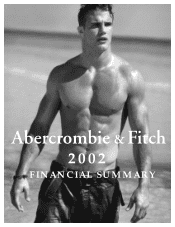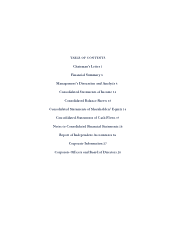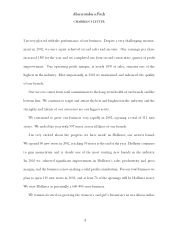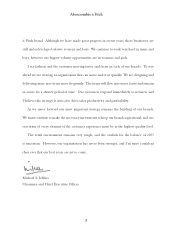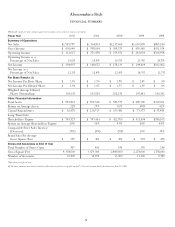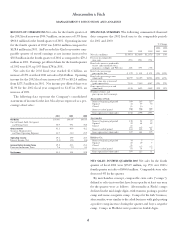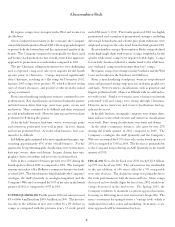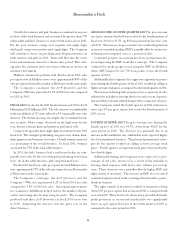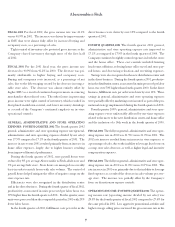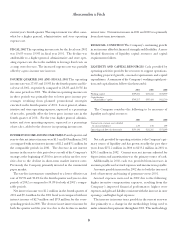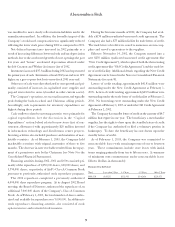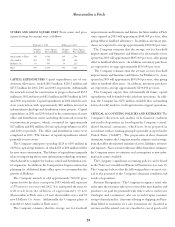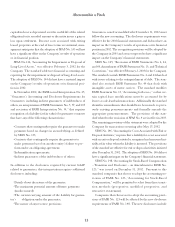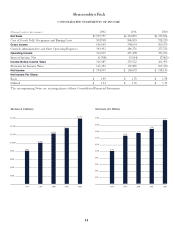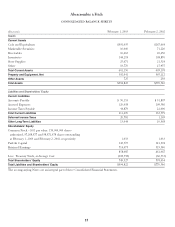Abercrombie & Fitch 2002 Annual Report Download - page 8
Download and view the complete annual report
Please find page 8 of the 2002 Abercrombie & Fitch annual report below. You can navigate through the pages in the report by either clicking on the pages listed below, or by using the keyword search tool below to find specific information within the annual report.
By regions, comps were strongest in the West and weakest in
the Midwest.
Given continued uncertainty in the economy, the Company
entered the fourth quarter of fiscal 2002 with an approach designed
to protect both the bottom line and the aspirational quality of the
brands. The Company continued to strategically use direct mail
and bounce-back promotions, but, overall, a much less aggressive
approach to promotions was undertaken compared to 2001.
The pre-Christmas selling environment was very challenging
and, as expected, comp store sales were negative for the fourth
quarter prior to Christmas. Comps improved significantly
after Christmas, resulting in a flat comp for December 2002.
January 2003 comps were positive 3%, which reflected strong
sales of winter clearance, and positive results from the initial
spring assortment.
From a merchandising standpoint, womens continued to out-
perform mens. Key classifications in womens during the quarter
included woven shirts, knit tops, outerwear, pants, sweats and
underwear. Mens continued to be difficult and there remained
no solid trend industry-wide. However, knit tops and woven shirts
performed well during the quarter.
As for the kids’ business, knit tops, sweats, woven tops, pants
and outerwear performed very well in girls. In boys, denim
and sweats performed best. As in the adult business, boys con-
tinued to be difficult.
In Hollister, girls continued to be more significant than guys, rep-
resenting approximately 65% of the overall business. For the
quarter, the best performing girls classifications were woven shirts,
knit tops, sweats, skirts and denim. In guys, denim, knit tops,
graphic t-shirts, sweatshirts and accessories performed best.
Sales in the e-commerce business grew by over 25% during the
fourth quarter of fiscal 2002 as compared to 2001. The Company
remains on track to add a Hollister e-commerce business for back-
to-school 2003. The direct business (which includes the Company’s
catalogue, the A&F Quarterly (a catalogue/magazine) and the
Company’s Web sites) accounted for 5.0% of net sales in the fourth
quarter of 2002 as compared to 4.5% in 2001.
FOURTH QUARTER 2001 Fourth quarter 2001 net sales increased
6% to $466.6 million from $439.4 million in 2000. The increase
was due to the addition of new stores offset by a 9% decline in
comps as compared with the previous year’s 13-week period
Abercrombie &Fitch
ended February 3, 2001. The fourth quarter of 2001 was highly
promotional and a number of promotional strategies, including
direct mail, bouncebacks and selective price point reductions, were
employed to improve the sales trend from the third quarter 2001.
By merchandise concept, Abercrombie & Fitch’s comps declined
in the high-single digits with women’s comps roughly flat for the
quarter while men’s comps were negative double digits. Comps
for our kids’ business followed a similar trend to the adult busi-
ness with girls’ comps much stronger than boys’ comps.
By regions, comps were strongest in the Northeast and the West
Coast and weakest in the Southeast and Midwest.
From a merchandising standpoint, womens outperformed
mens and generated strong comp increases in denim, graphic tees
and skirts. Newer women’s classifications, such as gymwear and
lingerie performed well. Mens was difficult with no solid indus-
try-wide trend. Similar to womens, men’s denim consistently
performed well and comps were strong through Christmas.
However, men’s outerwear and sweater classifications had sig-
nificant decreases.
In the kids’ business, strong girls’ categories were denim, skirts,
knits and accessories while sweaters and outerwear classifications
were weak. Boys’ strong classifications were knits and denim.
In the adult e-commerce business, sales grew by over 27%
during the fourth quarter of 2001 compared to 2000. The
Company’s catalogue, the A&F Quarterly and the Company’s
Web sites accounted for 4.5% of net sales in the fourth quarter of
2001 as compared to 5.0% in 2000. The decrease is primarily due
to the Company not producing an A&F Quarterly in the fourth
quarter of 2001.
FISCAL 2002 Net sales for fiscal year 2002 reached $1.6 billion,
up 17% over fiscal year 2001. The sales increase was attributable
to the net addition of 106 stores offset by a 5% comparable
store sales decrease. The decline in comps was primarily due to
the weak performance in both the mens and boys. Men’s comps
decreased in low-double digits for fiscal year 2002 while boys’
comps decreased in the mid-teens. For Spring 2003, the
Company continues to maintain a cautious approach in mens,
focusing on delivering more new items more frequently. The
men’s assortment for spring features a “vintage look” which is
emphasized in washes, colors and marketing. As in mens, a cau-
tious approach will be maintained in boys.
5

